光电子学与光子学讲义-Chapter0-perface
- 格式:ppt
- 大小:1.56 MB
- 文档页数:39
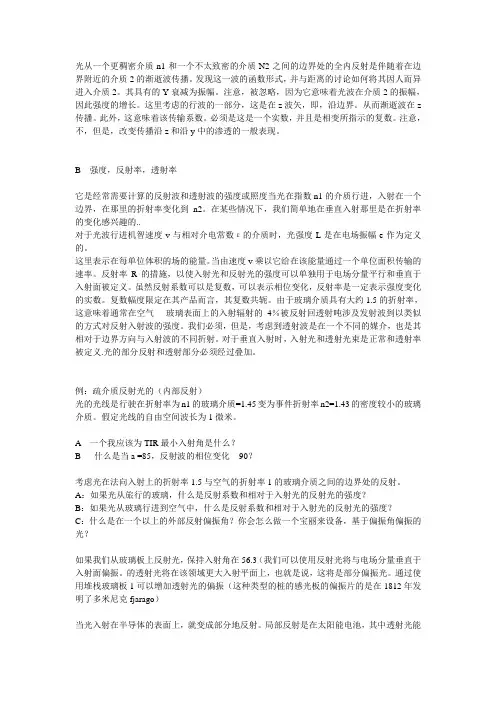
光从一个更稠密介质n1和一个不太致密的介质N2之间的边界处的全内反射是伴随着在边界附近的介质2的渐逝波传播。
发现这一波的函数形式,并与距离的讨论如何将其因人而异进入介质2。
其具有的Y衰减为振幅。
注意,被忽略,因为它意味着光波在介质2的振幅,因此强度的增长。
这里考虑的行波的一部分,这是在z波矢,即,沿边界。
从而渐逝波在z 传播。
此外,这意味着该传输系数。
必须是这是一个实数,并且是相变所指示的复数。
注意,不,但是,改变传播沿z和沿y中的渗透的一般表现。
B 强度,反射率,透射率它是经常需要计算的反射波和透射波的强度或照度当光在指数n1的介质行进,入射在一个边界,在那里的折射率变化到n2。
在某些情况下,我们简单地在垂直入射那里是在折射率的变化感兴趣的..对于光波行进机智速度v与相对介电常数ε的介质时,光强度L是在电场振幅e作为定义的。
这里表示在每单位体积的场的能量。
当由速度v乘以它给在该能量通过一个单位面积传输的速率。
反射率R的措施,以使入射光和反射光的强度可以单独用于电场分量平行和垂直于入射面被定义。
虽然反射系数可以是复数,可以表示相位变化,反射率是一定表示强度变化的实数。
复数幅度限定在其产品而言,其复数共轭。
由于玻璃介质具有大约1.5的折射率,这意味着通常在空气- 玻璃表面上的入射辐射的4%被反射回透射吨涉及发射波到以类似的方式对反射入射波的强度。
我们必须,但是,考虑到透射波是在一个不同的媒介,也是其相对于边界方向与入射波的不同折射。
对于垂直入射时,入射光和透射光束是正常和透射率被定义.光的部分反射和透射部分必须经过叠加。
例:疏介质反射光的(内部反射)光的光线是行驶在折射率为n1的玻璃介质=1.45变为事件折射率n2=1.43的密度较小的玻璃介质。
假定光线的自由空间波长为1微米。
A 一个我应该为TIR最小入射角是什么?B 什么是当a =85,反射波的相位变化- 90?考虑光在法向入射上的折射率1.5与空气的折射率1的玻璃介质之间的边界处的反射。
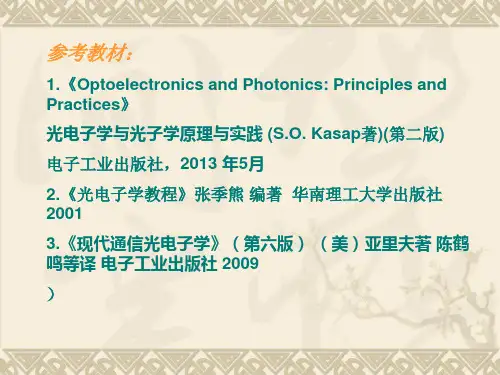
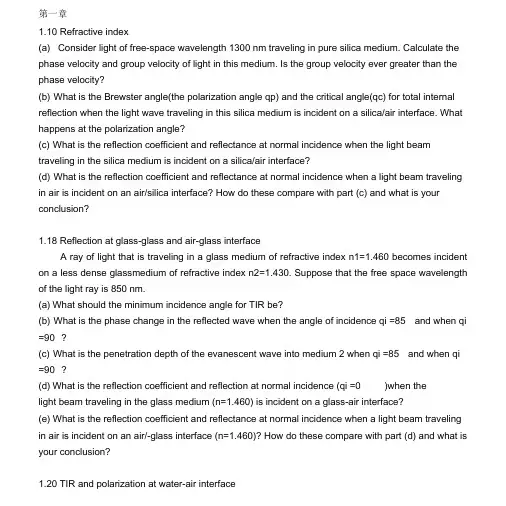
第一章1.10 Refractive index(a) Consider light of free-space wavelength 1300 nm traveling in pure silica medium. Calculate the phase velocity and group velocity of light in this medium. Is the group velocity ever greater than the phase velocity?(b) What is the Brewster angle(the polarization angle qp) and the critical angle(qc) for total internal reflection when the light wave traveling in this silica medium is incident on a silica/air interface. What happens at the polarization angle?(c) What is the reflection coefficient and reflectance at normal incidence when the light beam traveling in the silica medium is incident on a silica/air interface?(d) What is the reflection coefficient and reflectance at normal incidence when a light beam traveling in air is incident on an air/silica interface? How do these compare with part (c) and what is your conclusion?1.18 Reflection at glass-glass and air-glass interfaceA ray of light that is traveling in a glass medium of refractive index n1=1.460 becomes incident on a less dense glassmedium of refractive index n2=1.430. Suppose that the free space wavelength of the light ray is 850 nm.(a) What should the minimum incidence angle for TIR be?(b) What is the phase change in the reflected wave when the angle of incidence qi =85 ° and when qi =90° ?(c) What is the penetration depth of the evanescent wave into medium 2 when qi =85 ° and when qi =90° ?(d) What is the reflection coefficient and reflection at normal incidence (qi =0 ° )when thelight beam traveling in the glass medium (n=1.460) is incident on a glass-air interface?(e) What is the reflection coefficient and reflectance at normal incidence when a light beam traveling in air is incident on an air/-glass interface (n=1.460)? How do these compare with part (d) and what is your conclusion?1.20 TIR and polarization at water-air interface(1) Given that the refractive index of water is about 1.33, what is the polarization angle for light traveling in air and reflected from the surface of the water?(2) consider a diver in sea pointing a flashlight towards the surface of the water. What is the critical angle for the light beam to be reflected from the water surface?1.22 phase changes on TIRConsider a lightwave of wavelength 870nm traveling in a semiconductor medium (GaAs) of refractive index 3.6. It is incident on a different semiconductor medium (AIGaAs) of°. Will this result in total internal refractive index 3.4, and the angle of incidence is 80reflection? Calculate the phase change in the parallel and perpendicular components of the reflected electric field?1.25 Goos-Haenchen phase shiftAray of light that is traveling in a glass medium(1) of refractive index n1 =1.460 becomes incident on a less dense glass medium(2) of refractive index n2=1.430. Suppose that the free space wavelength of the light ray is 850nm.the angle of incidence(9=85 . Estimate the lateral Goos-Haenchen shift in the reflected wave for the perpendicular field component. Recalculate the Goos-Haenchen shift in the secondmedium has n2=1 (air). What is your conclusion?Assume that the virtual reflection occurs from a virtual plane in medium B at a distance d that is roughly the same as the penetration depth.Note that d actually depends on the polarization ,the direction of the field,but we will ignore this dependence.第二章作业习题:2.7Dielectric slab waveguide Consider a dielectric slab waveguide that has a thin GaAs layer of thickness 0.25 /w between two AIGaAs layers. The refractive index of GaAs is3.6 and that of the AIGaAs layers is 3.40. What is the cut-off wavelength beyond which only a single mode can propagate in the waveguide, assuming that the refractive index does not vary greatly with thewavelength? If a radiation of wavelength 860 nm (corresponding to bandgap radiation) is propagating in the GaAs layer, what is the penetration of the evanescent wave into the AIGaAs layer? What is the mode field width (MFW) of this radiation? Point out the effect of change of radiation wavelength (为on the MFW.2.9 Dielectric slab waveguide Consider a planar dielectric waveguide with a core thickness 10/m,ni=1.4446, n2=1.4440. Calculate the V -number, the mode angle 劣for m=0 (use a graphical solution, if necessary), penetration depth, and mode field distance (MFW=2 c(^2 9, for light wavelengths of 1.0 /xn and 5 /jn. What is your conclusion? Compare your MFW calculationwith 2»o =2a (V +1 )/V .The model angle 3is given as &=88.85?for ^=1 /m and ^=88.72 ?for ^=1.5 仰for the fundamental mode m=0.2.10 A multimode fibe r Consider a multimode fiber with a core diameter of 60 /m, core refractive index of 1.47, and a cladding refractive index of 1.45 both at 870 nm. Consider operating this fiber at ^=870nm.(e) Calculate the numerical aperture.(f) Find out the normalized core-cladding index difference.(g) Calculate the V-number for the fiber and estimate the number of guided modes.(h) Calculate the wavelength beyond which the fiber becomes single-mode.(i) Calculate the modal dispersion △ T and hence the bit rate x distance product.2.12 Single mode fiber Consider a fiber with a S1O2-13.5% GeOz core of diameter of 6 Wi and refractive index of 1.47 and a cladding refractive index of 1.46 both refractive indices at 1300 nm where the fiber is to be operated using a laser source with a half maximum width (FWHM) of 2 nm.. (j) Calculate the V -number for the fiver.(k) what is the maximum allowed diameter of the core that maintains oprations in single-mode?(l) Calculate the wavelength below which the fiber becomes multimode.(m) C alculate the numerical aperture.(n) Calculate the maximum acceptance angle.(o) Obtain the material dispersion and wavelength dispersion and hence estimate the bit rate x distance product ( B x L) of the fiber.。
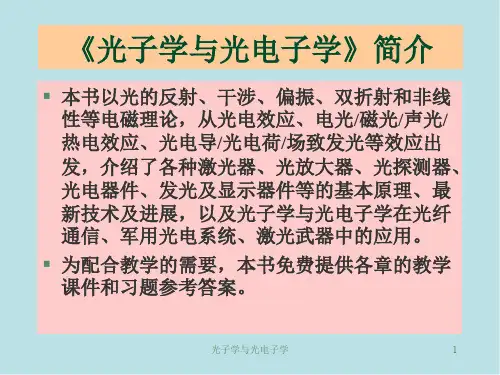

1、从三维到零维的态密度态密度推导:三维:为「概括ii 抻侧鳗分布状况.引人定义为正常 中能V E 附近刺位能址间隔内的电予志散.假设在能址E-E-dE 向无限小的能量间隔内有田、个电子忘.*M «(E >为A *号体片侑底成偷带顶附近.尊能■近位为球形.*i 电子志 4 4空间的分布职均与的.密度为V (2X )1. M 中V 隹品体体机. 代此。
能址E - E + dE 何的电干杰散为(分割以导带底或价借KI 为能ttTA >=盘1_牛二1 —三二 ‘(2K F A •2 A,我'(会)"'盹 即只白有效质量为"I •的导带电F 或价带空穴在刺但体枳内的急密度<(£)为邮> =!(芸广即 ⑷⑶式《413)盘明移价宙m 成铮带成附近.能右*度陆能址注携变 It."带边£ = 0处杰密度也为0.Quantum Well 半#体#带和价带中的电干建缴洋常浦集, 彬成用连技分布.Bulk Quantum Wire Quantum Dot二维(量子阱):6, 6, Q 2、/7 + + TT 叭% V ,z) + /(x, y, z\f(x,y,z) = E 叭x, y, z) dy Qz ) tl f —y/(z)+ E 此)2m dz叭 x, y)=A exp{ik x x + ik Y y) E =——―—• ZmU y/(x,^) = i//(x + L,y + L )= A expz^^ + L )+k y (y + £))=J (exp i(k x x + Ze v y)exp i{k x L + 如1))= “(x, j ,)exp ,(kxl+ k y L ) v £2 mEN =——— 1 dN _ 1 d (L 2mE yU~dE~lF~dE\ltl^ t 一维(纳米。
以 tt fn 站构中.电子在1和y 方向上的运命受胃限制.只 厦沿匚方向n 由近功.h 2 2in dx m 7t Tr P (E )二 2 m Ti 2成为市一维体系.殳八、方向上的幼阱均为无阳株方们阱.阱童分割为“、b.明它的整5以、岐1°且1,1<¥V(r)= < (4-24))g |1|>品・或lyl>¥根8■胃到体事的It函敷民/(r)= r‘ 二:心工L:,,〈中..J e 。
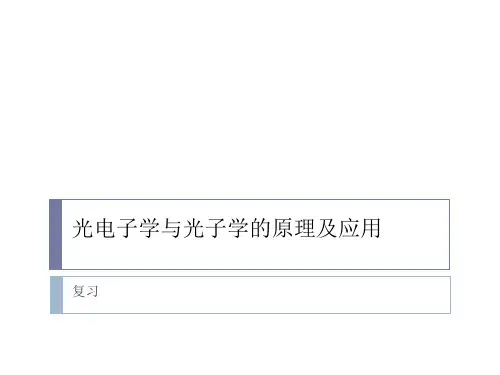

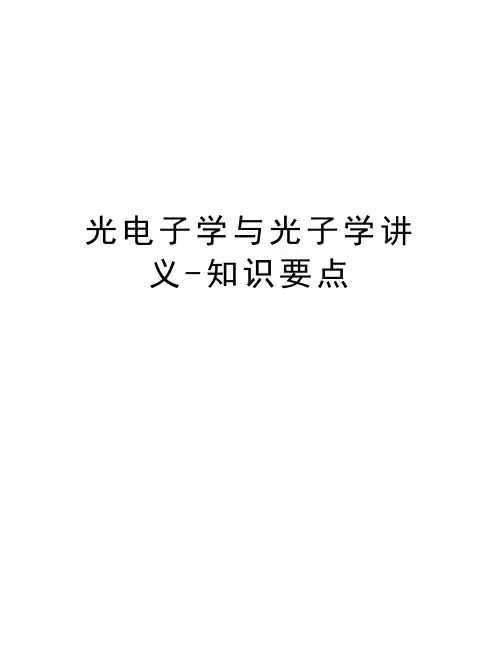
光电子学与光子学讲义-知识要点《光电子学》知识要点第0章光的本性,波粒二像性, 光子的特性第一章1.了解平面波的表示形式及性质,了解球面波、发散波的特点2.理解群速度的定义及物理意义和光波波前的传播方向的矢量表示、能量的传播方向的矢量表示3.理解描述反射和折射的菲涅尔公式的物理意义,掌握垂直入射情况下的反射率和透射率的计算公式和布儒斯特角4.理解全反射情况下导引波和倏逝波的形成和特点,了解古斯-汉森位移。
5.掌握垂直入射时反射系数的公式,理解反射率和透射率定义,不会计算6.掌握布儒斯特角的定义和特点。
7.掌握光波相干条件。
理解薄膜干涉的物理机制和增透膜、增反膜的形成条件。
8.FP腔的特点和模式谱宽同反射镜反射率之间的关系。
9.了解衍射现象产生条件,理解波动光学处理光的衍射的基本方法。
了解单缝、矩形空、圆孔的衍射图案特征和弗朗和费多缝光栅、衍射光栅、闪耀光栅的特点。
10.理解光学系统的分辨本领的决定因素。
什么是瑞利判据?理想光学系统所能分辨的角距离公式。
第二章1.了解光波导的结构特征和分类,理解平面波导导模形成条件,会利用一种方法推导平面介质波导的导波条件(特征方程),截止状态的特点2.理解光纤色散的概念,掌握材料色散、波导色散、颜色色散、剖面色散、偏振模色散的特点及形成原因3.了解阶跃折射率光纤的分析方法及相关参数的物理意义,会利用V参数计算光纤的结构参数4.掌握光纤中的损耗的成因及分类,掌握损耗的描述和计算。
5.了解G.651、G.652、G.653、G.654、G.655、色散补偿光纤的特点,熟悉G.652的主要参数。
第三章1.了解pn结的空间电荷区的形成、掌握pn结动态热平衡的物理意义。
2.了解pn结外加正向偏压和外加反向偏压时的特性(空间电荷区、势垒以及载流子的变化规律)。
3.掌握LED的工作原理(即pn结注入发光的基本原理)并理解同质结LED 和异质结LED的区别4.掌握LED的内量子效率与外量子效率的物理意义,和有源区半导体材料带隙宽度与发射波长的关系,以及温度等因素对发射波长的影响5.理解LED特性参数(光谱宽度,发散角,输出光功率,调制速度,阈值)的物理意义,了解LED结构的特点。


